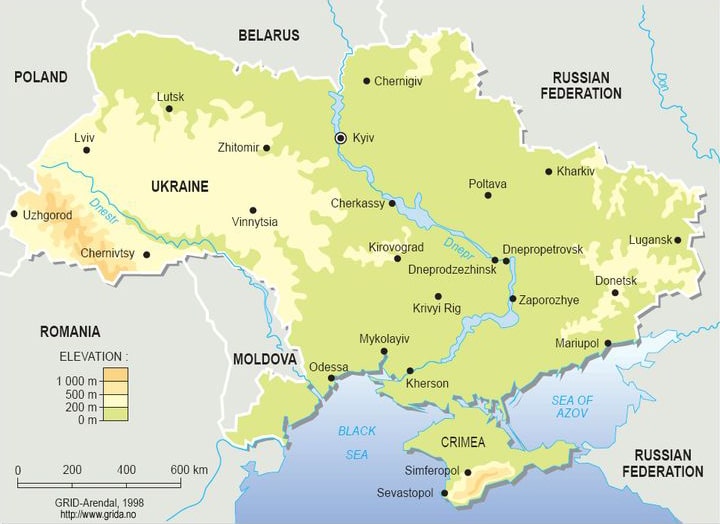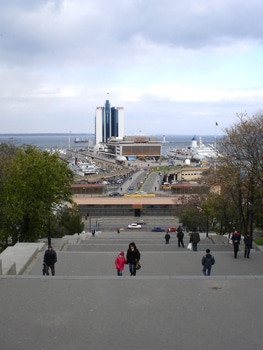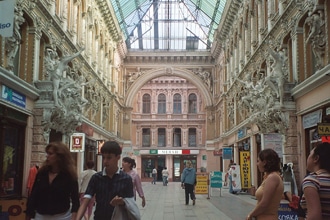As the third largest city in Ukraine, Odessa has a rich and eclectic history. Located on the Black Sea, about 450 km south of Kiev, the city has always been known for its cosmopolitan atmosphere as a major seaport and trade center. Odessa’s six warm-water harbors are located at the basin of two great rivers, the Dnieper and the Dniester.

Topographic map of Ukraine. Odessa is in the far south, bordering the Black Sea, near Moldova.


The ruins of the ancient Greek colony Khersones, located a few hours from Odessa today best showcase Ukraine’s Greek heritage.
As an open port, the city served as Russia’s chief grain-exporting center. Its importance as an industrial center and transportation hub was further spurred by the expansion of the railroad in the second half of the 19th century, which connected the city to Kiev and Romania. Odessa’s economy was also bolstered by considerable limestone deposits, a building material that was used to build most of the buildings in the city throughout the 19th century.
In 1905, Odessa was the scene of a worker’s revolt led by sailors from the battleship Potemkin. This event was immortalized in Sergei Eisenstein’s legendary 1925 silent film, The Battleship Potemkin – although not entirely accurately. The film depicts the tsarist army massacring hundreds of local citizens on a flight of 200 magnificent granite steps then widely known as “The Boulevard Steps” that had been constructed to increase access from the hill-top city to the port below. Although the steps are now popularly known as “The Potemkin Steps,” the massacre actually occurred in the nearby city streets.

The Boulevard Steps in Odessa. They were made famous by Sergei Eisenstein’s 1925 silent film, The Battleship Potemkin.
Following the 1917 Bolshevik Revolution, the city was successively occupied by several powers including a short-lived, independent Ukrainian national government, the French, the Reds, and the Whites. The Red Army definitively took over in 1920 and united the city with the Ukrainian Soviet Socialist Republic. Largely due to the destruction caused by the WWI and Russian Civil War, and partly due to early attempts by the Soviets to requisition agricultural products and other factors, the great grain exporter of Odessa suffered a famine in 1921 – 22, and lost a good portion of its population.
The city’s sufferings were continued in World War II, when it was occupied by Romanian and German forces from 1941-1944. The city’s large Jewish population was largely eliminated. In total, about 60,000 Odessans were killed or deported. The city was also the site of extensive partisan activity – accommodated partly by the extensive limestone caves in the surrounding countryside which served as shelter and refuge for the partisans. The Axis occupation would not end, however, until the Soviet Army returned in 1944. Odessa was awarded the title of “Hero City” the following year.
Despite all this destruction, the city grew rapidly after the war due mostly to an influx of rural people who moved to Odessa seeking economic opportunity as the Soviets rebuilt the city. Today, the city has over a million people and retains its unique mix of Slavic and Mediterranean cultures, which is reflected in its eclectic and colorful mix of architectural styles which mix Catherine’s favorite neoclassical style with Italian baroque, Russian and Soviet styles. Also present are several exquisite examples of art-deco architecture, built in the first two decades after the Soviets took over the city.

Odessa Passage is a beautiful 19th-century building that now serves as a modern shopping mall.
Signs of a post-communist economic revival are only now beginning to appear. Several of the city’s streets are now lined with shops, coffee houses and chic cafes. The city offers a bewildering assortment of national cuisines from Aztec to Lebanese to traditional Ukrainian. It is not at all uncommon to meet foreign business persons along these streets, as they seek opportunity in the still-turbulent but growing Ukrainian economy. Tourists are also not uncommon, as the city’s numerous beaches, mud-bathes, and therapeutic reports make it a popular destination in the summer.
Find Out More About Programs in Ukraine



